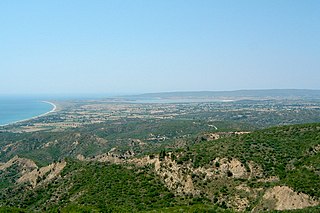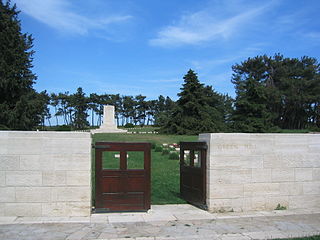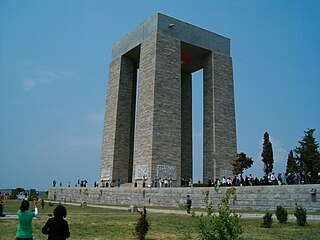
The Gallipoli campaign, the Dardanelles campaign, the Defense of Gallipoli or the Battle of Gallipoli was a military campaign in the First World War on the Gallipoli peninsula from 19 February 1915 to 9 January 1916. The Entente powers, Britain, France and the Russian Empire, sought to weaken the Ottoman Empire, one of the Central Powers, by taking control of the Ottoman straits. This would expose the Ottoman capital at Constantinople to bombardment by Entente battleships and cut it off from the Asian part of the empire. With Turkey defeated, the Suez Canal would be safe and a year-round Entente supply route could be opened through the Black Sea to warm-water ports in Russia.

The Battle of the Nek was a minor battle that took place on 7 August 1915, during the Gallipoli campaign of World War I. "The Nek" was a narrow stretch of ridge on the Gallipoli Peninsula. The name derives from the Afrikaans word for a "mountain pass" but the terrain itself was a perfect bottleneck and easy to defend, as had been proven during an Ottoman attack in June. It connected Australian and New Zealand trenches on the ridge known as "Russell's Top" to the knoll called "Baby 700" on which the Ottoman defenders were entrenched.

The Battle of Lone Pine was fought between Australian and New Zealand Army Corps (ANZAC) and Ottoman Empire forces during the Gallipoli Campaign of the First World War, between 6 and 10 August 1915. The battle was part of a diversionary attack to draw Ottoman attention away from the main assaults being conducted by British, Indian and New Zealand troops around Sari Bair, Chunuk Bair and Hill 971, which became known as the August Offensive.
The Battle of Sari Bair, also known as the August Offensive, represented the final attempt made by the British in August 1915 to seize control of the Gallipoli peninsula from the Ottoman Empire during the First World War.

The Battle of Hill 60 was one of the last major assault of the Gallipoli Campaign. It was launched on 21 August 1915 to coincide with the attack on Scimitar Hill made from the Suvla front by Major-General H. de B. De Lisle's British IX Corps, Frederick Stopford having been replaced in the few days previous. Hill 60 was a low knoll at the northern end of the Sari Bair range which dominated the Suvla landing. Capturing this hill along with Scimitar Hill would have allowed the Anzac and Suvla landings to be securely linked.

The Battle of Chunuk Bair was a World War I battle fought between the Ottoman defenders and troops of the British Empire over control of the peak in August 1915. The capture of Chunuk Bair,, the secondary peak of the Sari Bair range, was one of the two objectives of the Battle of Sari Bair.

The landing at Anzac Cove on Sunday, 25 April 1915, also known as the landing at Gaba Tepe and, to the Turks, as the Arıburnu Battle, was part of the amphibious invasion of the Gallipoli Peninsula by the forces of the British Empire, which began the land phase of the Gallipoli Campaign of the First World War.
This article presents the timeline of the Gallipoli Campaign. The period of the proper battle is considered to be 19 February 1915 to 9 January 1916; however, a number of events took place between August 1914 and January 1915 that are relevant to the battle.

Cyril Royston Guyton Bassett, VC was a New Zealand recipient of the Victoria Cross (VC), the highest award for gallantry "in the face of the enemy" that could be awarded to British and Empire forces at the time. He was the only soldier serving with the New Zealand Expeditionary Force (NZEF) to be awarded the VC in the Gallipoli Campaign of the First World War.

The landing at Suvla Bay was an amphibious landing made at Suvla on the Aegean coast of the Gallipoli peninsula in the Ottoman Empire as part of the August Offensive, the final British attempt to break the deadlock of the Battle of Gallipoli. The landing, which commenced on the night of 6 August 1915, was intended to support a breakout from the ANZAC sector, five miles (8 km) to the south.

Skew Bridge Cemetery is a Commonwealth War Graves Commission cemetery containing the remains of Allied troops who died during the Battle of Gallipoli, including the youngest British soldier.

Green Hill Cemetery is a Commonwealth War Graves Commission cemetery located near Suvla Bay, Gallipoli, Turkey.

The Çanakkale Martyrs' Memorial is a war memorial commemorating the service of about 253,000 Turkish soldiers who participated at the Battle of Gallipoli, which took place from April 1915 to December 1915 during the First World War. It is located within the Gallipoli Peninsula Historical National Park on Hisarlık Hill in Morto Bay at the southern end of the Gallipoli peninsula in Çanakkale Province, Turkey.

Hill 60 Cemetery is a Commonwealth War Graves Commission cemetery dating from World War I at the Northern end of the former Anzac sector of the Gallipoli Peninsula, Turkey and the location of Hill 60 Memorial, one of four memorials on the peninsula which commemorate New Zealanders killed in the campaign but who have no known grave.
The Farm Cemetery is a Commonwealth War Graves Commission cemetery on the Gallipoli Peninsula in Turkey. It contains the remains of some of the soldiers killed during World War I in the Battles at Gallipoli.

Lone Pine Cemetery is a Commonwealth War Graves Commission cemetery dating from World War I in the former Anzac sector of the Gallipoli Peninsula, Turkey and the location of the Lone Pine Memorial, one of five memorials on the peninsula which commemorate servicemen of the former British Empire killed in the campaign but who have no known grave.

The Helles Memorial is a Commonwealth War Graves Commission war memorial near Sedd el Bahr, in Turkey, on the headland at the tip of the Gallipoli peninsula overlooking the Dardanelles. It includes an obelisk which is over 30 metres (98 ft) high.

The battle for No.3 Post was fought during the Gallipoli Campaign in the First World War, between the forces of the New Zealand Mounted Rifles Brigade and the Turkish 19th Division.

Arthur Bauchop, was an officer in the New Zealand Military Forces who served in the Second Boer War and the First World War. He commanded the Otago Mounted Rifles during the Gallipoli Campaign, and died of wounds received during the Battle of Chunuk Bair.





















